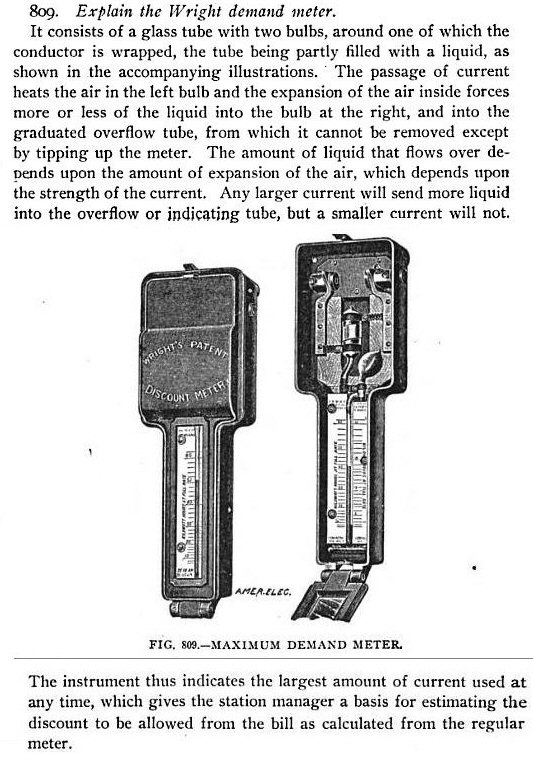Tuesday, March 20, 2012
1901 Smart meter
Yup, Shepardson again!
While reading the printed edition, this gadget caught my attention:

Direct ancestor of the 'smart meter' now infesting many electric systems.
Holds an unalterable physical record of the highest current used since the last reset of the meter. Presumably the reset lever was only accessible after unlocking the outer case, so the customer couldn't reset.
Note two important differences between the 1901 and 2012 smart meters:
(1) Directness and honesty. The 1901 demand meter was analog and physical, and the reading was visible to the customer without any question. The modern version is digital and virtual, and the electric company can rig the reading without the customer's knowledge.
(2) In 1901 the utility used the highest current to figure a discount for large consumers. The generating company wanted to sell more electricity in order to bring the cost per unit down, and in order to have more cash available to improve their facilities. Now the 2012 smart meter serves to enforce the opposite policy, discounts for minimal use, thus increasing the cost per KWH and decreasing available capital.
We're stuck in this perpetual one-way mentality. Consumption of energy and water and trash must constantly decrease, even though the decrease causes huge inconvenience to the customer and new problems for the utilities.
Electric grids are overloaded with current from wind generators at the exact times when demand is lowest. Sewer pipes are clogging up, and the bacterial digesters are running badly, because lo-flo toilets don't dilute the shit enough. Some sewer systems constantly pour water into the sewer lines to compensate for the lo-flo!
Before the securitized Enron grid, we had balanced utility systems. We had learned how to make the systems work well, and we knew how to expand them. Now, thanks to Phil Gramm and the Gaians, we have unbalanced systems that require unnecessary maintenance. On top of the increased maintenance, lower consumption means rate per KWH must go up to cover expenses. And the raised rates make it impossible for many people to afford heat in winter, so they die.
Smart.
= = = = =
Here is an excellent article on the financial and commercial context of the Wright demand meter.
While reading the printed edition, this gadget caught my attention:

Direct ancestor of the 'smart meter' now infesting many electric systems.
Holds an unalterable physical record of the highest current used since the last reset of the meter. Presumably the reset lever was only accessible after unlocking the outer case, so the customer couldn't reset.
Note two important differences between the 1901 and 2012 smart meters:
(1) Directness and honesty. The 1901 demand meter was analog and physical, and the reading was visible to the customer without any question. The modern version is digital and virtual, and the electric company can rig the reading without the customer's knowledge.
(2) In 1901 the utility used the highest current to figure a discount for large consumers. The generating company wanted to sell more electricity in order to bring the cost per unit down, and in order to have more cash available to improve their facilities. Now the 2012 smart meter serves to enforce the opposite policy, discounts for minimal use, thus increasing the cost per KWH and decreasing available capital.
We're stuck in this perpetual one-way mentality. Consumption of energy and water and trash must constantly decrease, even though the decrease causes huge inconvenience to the customer and new problems for the utilities.
Electric grids are overloaded with current from wind generators at the exact times when demand is lowest. Sewer pipes are clogging up, and the bacterial digesters are running badly, because lo-flo toilets don't dilute the shit enough. Some sewer systems constantly pour water into the sewer lines to compensate for the lo-flo!
Before the securitized Enron grid, we had balanced utility systems. We had learned how to make the systems work well, and we knew how to expand them. Now, thanks to Phil Gramm and the Gaians, we have unbalanced systems that require unnecessary maintenance. On top of the increased maintenance, lower consumption means rate per KWH must go up to cover expenses. And the raised rates make it impossible for many people to afford heat in winter, so they die.
Smart.
= = = = =
Here is an excellent article on the financial and commercial context of the Wright demand meter.
Labels: 20th century Dark Age
